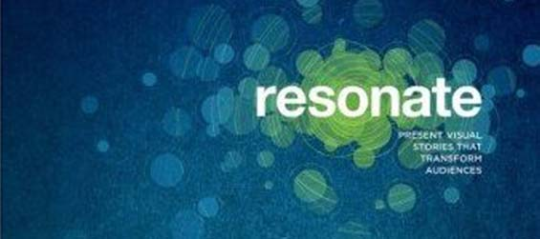
Resonate: Present Visual Stories that Transform Audiences (review)
- Title:Resonate: Present Visual Stories that Transform Audiences
- Author:Nancy Duarte
- Paperback: 272 pages
- Publisher: Wiley; 1 edition (September 28, 2010)
- Language: English
- ISBN-10: 0470632011
- ISBN-13: 978-0470632017
This is a wonderful book – I follow Nancy Duarte on Twitter and often read her interesting blog posts; if you want one book that could enhance the way you build presentations, this is the book. I was mentoring a direct report who was creating a very short presentation while reading this, and I used a number of the concepts inside immediately.
“Showing your humanness when you present is a great way to stand out.” (P. 16) It’s important to provide a story; Duarte spends perhaps a fifth of the book discussing the standard Hollywood story of the adventurer. This is quite useful because that typical quest is a path to making your presentation make a difference. Since the goal of a presentation is to change minds, you need to know your audience: “Remember, people you don’t know are difficult to influence.” (P. 69)
I really loved the section on MECE (Mutually Exclusive and Collectively Exhaustive):
- “Mutually Exclusive: Each idea should be mutually exclusive and not overlap with the others; otherwise you will confuse the audience. (“Hey, haven’t we talked about the acquisition already?”)
- Collectively Exhaustive: Don’t leave anything out. If you plan to talk about your competitors, you should not mysteriously leave one out. The audience expects you to be complete. (P. 142)”
Structure is an important part of any presentation, “To make sure your audience will “see” the structure, eliminate these linear constraints and create an environment that lets you view your content spatially.” (P. 149)
Duarte lists 4 common story forms: chronological, sequential, spatial, and climactic. (P. 153) And there are also 4 common contrasts you can use: problem-solution, compare-contrast, cause-effect, and advantage-disadvantage (P. 154)
“Create a moment where you dramatically drive the big idea home by intentionally placing Something They’ll Always Remember—a S.T.A.R. moment—in each presentation.” (P. 173) There are five types of S.T.A.R. moments: Memorable Dramatization, Repeatable Sound Bites, Evocative Visuals, Emotive Storytelling, and Shocking Statistics. (P. 174) Some powerful rhetorical devices to create a powerful soundbite:
- “Imitate a famous phrase: Golden Rule: Do unto others as you would have them do unto you.
- “Imitation: Never give a presentation you wouldn’t want to sit through yourself.
- “Repeat words at the beginning of a series: “It was the best of times, it was the worst of times, it was the age of wisdom, it was the age of foolishness…” Charles Dickens, A Tale of Two Cities
- “Repeat words in the middle of a series: “We are troubled on every side, yet not distressed; we are perplexed, but not in despair; persecuted, but not forsaken; cast down, but not destroyed…” Apostle Paul to the Corinthians
- “Repeat words at the end of a series: “…and that government of the people, by the people, for the people shall not perish from the earth.” Abraham Lincoln, Gettysburg Address” (P. 181)
“There are four main types of noise that can interfere with your signal: credibility, semantic, experiential, and bias noise.” (P. 198) It’s important to connect with your audience; that initial connection occurs during the first seconds of the pitch. It’s important that the connection be authentic because trust is an important element in acceptance of the change you want to create. “Presentations fail because of too much information, not too little.” (P. 206) “Your goal is to move away from projecting a document and toward giving a presentation. Reduce large phrases and bodies of copy to single words. Simplify the slides so the audience can process it in under three seconds.” (P. 110) “There’s another Greek word in the mix in addition to ethos, pathos, and logos (see page 115). That word is karios. It means ‘timing’ or ‘timelines’—’speaking in the right moment, in the right way.'” (p. 212) Pacing is critical – pauses, short vs long sentences, and vocal pitch all play an important part in conveying ideas.
“Contrast keeps a presentation interesting. The same is true with music.
- “Tonal contrast: Put simply, tonal contrast is key changes. Music has a “home” and that home is the tonic key. The beauty of harmony is that the human ear recognizes when we are away from home and when we are home.
- “Dynamic contrast: Dynamic contrast is created when the music alternates between loud and soft. Sometimes the transition is sudden, while other times it is gradual.
- “Textural contrast:
- “a. Polyphony/Monophony—Throughout the piece there is always a clear melodic line. Sometimes all the instruments play the same melody in unison (monophony), and other times one instrument plays the melody while the others complement and accompany the melody (polyphony).
- “b. Density—The number of notes played per measure determines the density. Sometimes there are only a few notes per measure, while at other times there are many, often being played at the same time.” (Pp. 256-257)
There’s so much more I could have included here – I learned and re-learned a lot from this book and I think you will as well.
Revisions:
There are no revisions for this post.







May 14th, 2012 by alephnaught